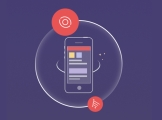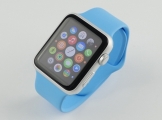|
我正在使用 viewWillLayoutSubviews 来检测方向变化,但在 iOS 8 和 Xcode 6 中已弃用,我需要使用新的 viewWillTransitionToSize。我的问题是我无法使用它。
我的 viewWillLayoutSubviews 是:
- (void)viewWillLayoutSubviews{
NSInteger maxQuantityForWidth = MAX(3, [self.barButtons count]);
CGFloat buttonWidth = (CGRectGetWidth(self.tabBar.bounds) - (kBarButtonSeparation * (maxQuantityForWidth - 1))) / maxQuantityForWidth;
for (NSInteger i = 0; i < [self.barButtons count]; i++) {
[self.barButtons[i] setFrame:CGRectMake(i * ((buttonWidth + kBarButtonSeparation)), 2.0, buttonWidth, CGRectGetHeight(self.tabBar.bounds) - 2.0)];
}
if ([self isShowingTabBar]) {
self.functionalityContainer.frame = CGRectMake(0.0, CGRectGetHeight(self.tabBar.bounds), CGRectGetWidth(self.view.bounds), CGRectGetHeight(self.view.bounds) - CGRectGetHeight(self.tabBar.bounds));
} else {
self.functionalityContainer.frame = self.view.bounds;
}
if (IS_IPAD){
[self updateToolbar];
CGRect frame = self.slidingViewController.topViewController.view.frame;
if (LANDSCAPE) {
frame.size.width = 700;
} else {
frame.size.width = 768;
}
[self.slidingViewController.topViewController.view setFrame:frame];
}
}
它是使用 ECSLidingViewController 的导航部分的一部分。
我尝试了以下方法:
- (void) viewWillTransitionToSize CGSize)size withTransitionCoordinator CGSize)size withTransitionCoordinator id<UIViewControllerTransitionCoordinator>)coordinator {
[coordinator animateAlongsideTransition:^(id<UIViewControllerTransitionCoordinatorContext> context) {
[self updateToolbar];
} completion:^(id<UIViewControllerTransitionCoordinatorContext> context) {
if (IS_IPAD){
CGRect frame = self.slidingViewController.topViewController.view.frame;
if (LANDSCAPE) {
NSInteger maxQuantityForWidth = MAX(3, [self.barButtons count]);
CGFloat buttonWidth = (758 - (kBarButtonSeparation * (maxQuantityForWidth - 1))) / maxQuantityForWidth;
for (NSInteger i = 0; i < [self.barButtons count]; i++) {
[self.barButtons[i] setFrame:CGRectMake(i * ((buttonWidth + kBarButtonSeparation)), 2.0, buttonWidth, CGRectGetHeight(self.tabBar.bounds) - 2.0)];
}
frame.size.width = 768;
} else {
NSInteger maxQuantityForWidth = MAX(3, [self.barButtons count]);
CGFloat buttonWidth = (758 - (kBarButtonSeparation * (maxQuantityForWidth - 1))) / maxQuantityForWidth;
for (NSInteger i = 0; i < [self.barButtons count]; i++) {
[self.barButtons[i] setFrame:CGRectMake(i * ((buttonWidth + kBarButtonSeparation)), 2.0, buttonWidth, CGRectGetHeight(self.tabBar.bounds) - 2.0)];
}
frame.size.width = 768;
}
[self.slidingViewController.topViewController.view setFrame:frame];
}
if([self isShowingTabBar]){
[self showTabBar];
}else{
[self hideTabBar];
}
if (IS_IPAD && LANDSCAPE) {
self.slidingViewController.resetStrategy = ECNone;
[self.navigationItem setLeftBarButtonItems id<UIViewControllerTransitionCoordinator>)coordinator {
[coordinator animateAlongsideTransition:^(id<UIViewControllerTransitionCoordinatorContext> context) {
[self updateToolbar];
} completion:^(id<UIViewControllerTransitionCoordinatorContext> context) {
if (IS_IPAD){
CGRect frame = self.slidingViewController.topViewController.view.frame;
if (LANDSCAPE) {
NSInteger maxQuantityForWidth = MAX(3, [self.barButtons count]);
CGFloat buttonWidth = (758 - (kBarButtonSeparation * (maxQuantityForWidth - 1))) / maxQuantityForWidth;
for (NSInteger i = 0; i < [self.barButtons count]; i++) {
[self.barButtons[i] setFrame:CGRectMake(i * ((buttonWidth + kBarButtonSeparation)), 2.0, buttonWidth, CGRectGetHeight(self.tabBar.bounds) - 2.0)];
}
frame.size.width = 768;
} else {
NSInteger maxQuantityForWidth = MAX(3, [self.barButtons count]);
CGFloat buttonWidth = (758 - (kBarButtonSeparation * (maxQuantityForWidth - 1))) / maxQuantityForWidth;
for (NSInteger i = 0; i < [self.barButtons count]; i++) {
[self.barButtons[i] setFrame:CGRectMake(i * ((buttonWidth + kBarButtonSeparation)), 2.0, buttonWidth, CGRectGetHeight(self.tabBar.bounds) - 2.0)];
}
frame.size.width = 768;
}
[self.slidingViewController.topViewController.view setFrame:frame];
}
if([self isShowingTabBar]){
[self showTabBar];
}else{
[self hideTabBar];
}
if (IS_IPAD && LANDSCAPE) {
self.slidingViewController.resetStrategy = ECNone;
[self.navigationItem setLeftBarButtonItems [] animated:YES];
if (!self.slidingViewController.underLeftShowing) {
[self.slidingViewController anchorTopViewTo:ECRight];
}
} else {
self.slidingViewController.resetStrategy = ECTapping | ECPanning;
[self.navigationItem setLeftBarButtonItems [] animated:YES];
if (!self.slidingViewController.underLeftShowing) {
[self.slidingViewController anchorTopViewTo:ECRight];
}
} else {
self.slidingViewController.resetStrategy = ECTapping | ECPanning;
[self.navigationItem setLeftBarButtonItems [self.displayMenuBarButtonItem] animated:YES];
[self.slidingViewController resetTopView];
}
[self.slidingViewController.topViewController.view setNeedsDisplay];
[self.functionalityNavigationController.view setNeedsDisplay];
[self.view setNeedsDisplay];
}];
NSString *orientation = [[NSString alloc]initWithFormat [self.displayMenuBarButtonItem] animated:YES];
[self.slidingViewController resetTopView];
}
[self.slidingViewController.topViewController.view setNeedsDisplay];
[self.functionalityNavigationController.view setNeedsDisplay];
[self.view setNeedsDisplay];
}];
NSString *orientation = [[NSString alloc]initWithFormat "Larghezza: %f Altezza: %f", self.view.frame.size.width, self.view.frame.size.height];
[self.view makeToast "Larghezza: %f Altezza: %f", self.view.frame.size.width, self.view.frame.size.height];
[self.view makeToast rientation duration:3.0 position rientation duration:3.0 position "bottom"];
[super viewWillTransitionToSize: size withTransitionCoordinator: coordinator];
} "bottom"];
[super viewWillTransitionToSize: size withTransitionCoordinator: coordinator];
}
但它不起作用,当它是横向或纵向时,它似乎不“理解”。关于如何修复它的任何想法?
*** 编辑:
这里是我使用的定义
#define LANDSCAPE UIInterfaceOrientationIsLandscape(self.interfaceOrientation)
#define LANDSCAPE_RIGHT [UIDevice currentDevice].orientation == UIDeviceOrientationLandscapeLeft
#define LANDSCAPE_LEFT [UIDevice currentDevice].orientation == UIDeviceOrientationLandscapeRight
#define PORTRAIT UIInterfaceOrientationIsPortrait(self.interfaceOrientation)
#define PORTRAIT_REVERSE [UIDevice currentDevice].orientation == UIDeviceOrientationPortraitUpsideDown
Best Answer-推荐答案
这个问题似乎有点“老”,无论如何,至少随着 iOS9 的引入(尤其是多任务处理),不建议根据设备方向对当前屏幕格式下结论 - 相反,应该评估当前屏幕尺寸。以下指示屏幕格式是纵向还是横向:
- (void) viewWillTransitionToSize : (CGSize) screenSize withTransitionCoordinator : (id<UIViewControllerTransitionCoordinator> _Nonnull) coordinator
{
BOOL isLandscapeOrientation = (screenSize.width > screenSize.height);
...
...
}
关于ios - 如何将 viewWillLayoutSubviews 转换为 viewWillTransitionToSize,我们在Stack Overflow上找到一个类似的问题:
https://stackoverflow.com/questions/26697368/
|  客服电话
客服电话
 APP下载
APP下载

 官方微信
官方微信
















 CGSize)size withTransitionCoordinator
CGSize)size withTransitionCoordinator [] animated:YES];
if (!self.slidingViewController.underLeftShowing) {
[self.slidingViewController anchorTopViewTo:ECRight];
}
} else {
self.slidingViewController.resetStrategy = ECTapping | ECPanning;
[self.navigationItem setLeftBarButtonItems
[] animated:YES];
if (!self.slidingViewController.underLeftShowing) {
[self.slidingViewController anchorTopViewTo:ECRight];
}
} else {
self.slidingViewController.resetStrategy = ECTapping | ECPanning;
[self.navigationItem setLeftBarButtonItems rientation duration:3.0 position
rientation duration:3.0 position
